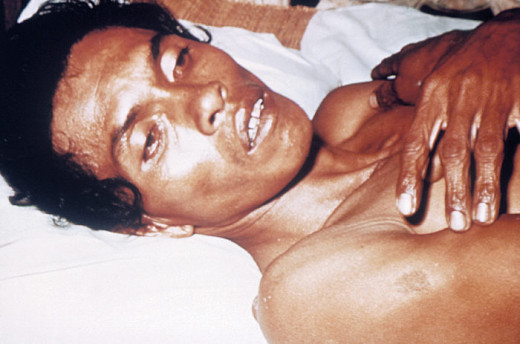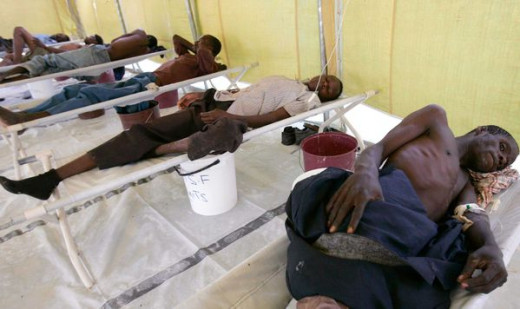Cholera As A Diarrheal Disease Of Infective Origin: Etiology, Epidemiology And Pathogenesis
An Adult Patient Suffering From Cholera

Etiology And Epidemiology Of Cholera
Cholera is an acute infectious disease occurring in outbreaks, characterized by watery diarrhea and effortless vomiting, often leading to severe dehydration and shock. The classical disease is caused by Vibrio cholera, but in the majority of outbreaks, occurring in especially India and neighbouring countries in recent times, the main pathogen is the el tor blotype. Cholera has been endemic in the banks of Ganges and Brahmaputra in India and Bangladesh for several centuries. From these endemic foci, the disease used to spread along routes of human communication to other parts during fairs, festivals, floods and famines, causing outbreaks associated with high mortality. Between 1817 and 1923, the disease swept to other parts of the world including Europe and America as pandemics on at least six occasions. El tor virbrio was identified as the cause of cholera-like disease during 1937 to 1938 in Celebes island of Indonesia. This was identified as a major pathogen causing diarrheal illness in India, Pakistan, Afghanistan, Iran, Iraq and Southern parts of USSR in 1965 to 1966. From this time, El tor vibrios are responsible almost exclusively for cases of cholera reported in this subcontinent.
Etiology and epidemiology: Vibrio cholera can be classified into Inaba, Ogawa and Hikojima based on the lipopolysaccharide O antigen. The classical Vibrio cholera, the causative agent of Asiatic cholera, was discovered by Robert Koch in 1884. Vibrio cholera biotype eltor resembles classical vibrio cholera in morphology and antigenicity, but it can be differentiated by phage typing and other tests. Though El tor biotype was originally hemolytic, recent studies show that this characteristic has been lost.
Man is natural reservoir. Spread occurs through the environment. Organisms are eliminated in feces of acute cases and carriers. Convalescent patients become temporary carriers. Convalescent patients become temporary carriers passing the organisms in feces for 4 to 7 days after an attack. Rarely chronic carrier state may develop and organisms may be present in feces for years. Unlike the explosive outbreaks of classical cholera, El tor epidermics follow a protracted pattern with a few cases occurring everyday for several weeks.
Cholera is predominantly a disease of the lower socio-economic groups living in gross insanitary conditions. The organisms are killed in the presence of normal gastric acidity. In different places cholera outbreaks follow seasonal patterns.
Several Patients Suffering From Cholera

Infectious Diseases
Pathogenesis Of Cholera
Vivrio cholera are ingested in food or drinks and they multiply in jejunum and small intestine and produce an enterotoxin. This toxin causes the enterocytes (intestinal mucosal cells) to secrete large amount of isotonic fluid. The rate of secretion of the fluid exceeds the rate of absorption which also goes on. The result is watery diarrhea which leads to the loss of isotonic fluid. The fluid loss accounts for all the clinical manifestations.
Cholera enterotoxin is a protein of molecular weight 84,000 made up of two immunologically distinct regions- A (active) and B (binding). The B region is composed of five subunits of molecular weight of about 11,500. This region of the cholera toxin is responsible for binding to host cell memebrane receptors containing GM 1-ganglioside. The binding enables the 28,000 MW ‘A’ region to penetrate the mucosal cells. This toxin leads to the formation of adenylate cyclase which induces excessive production of adenylate cyclase which induces excessive production of cyclic-AMP (CAMP), which in turn is responsible for oversecretion of electrolytes and water by the enterocytes. The exact mechanism of action of cyclic-AMP, however is not clear.
The pathophysiological changes result directly from the massive gastrointestinal loss of fluid isotonic with plasma. The feces are low in proteins and chloride, but relative rich in sodium, potassium and bicarbonate (sodium 126+9, potassium 19+9, bicarbonate 47+10, and chloride 95+9 mcq/liter). Excessive loss of fluid and electrolyte gives rise to hypovolemic shock and metabolic acidosis.
© 2014 Funom Theophilus Makama




